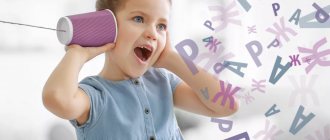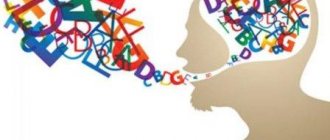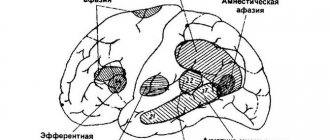Types of aphasia, causes and correction of aphasia
What is aphasia?
How serious is this speech pathology? Forms of aphasia: motor, sensory and total aphasia. Aphasia correction in Almaty. What are the causes of aphasia? Can aphasia be corrected? Is it possible to help adults with aphasia, or how successfully can aphasia be corrected in children? You will find detailed answers to all these questions in this article. Aphasia is one of the complex speech deviations of organic, central origin. The disorder, unlike other disorders, is caused by damage to the areas of the brain responsible for speech. The causes of such damage may be deterioration of blood circulation in the brain, traumatic brain injury, rheumatoid heart defects, thromboembolism, strokes, etc. Aphasia usually develops in people of old age, but can also affect young people and children.
With aphasia, partial speech impairment or complete loss may be observed.
The term "APHASIA" comes from the Greek language. The particle “a-” means negation, “phasis” means speech.
Aphasia appears when a person has already fully formed speech as a result of damage to the speech areas of the brain: the frontal, parietal, and temporal lobes.
How to treat aphasia, get rid of aphasia?
Sarklinik knows how to treat aphasia , speech disorders characterized by partial or complete loss of the ability to use words and phrases, how to get rid of aphasia in Saratov. A variety of reflexology treatment methods have helped many of our patients get rid of aphasia in right-handed and left-handed people. Effective treatment of aphasia gives excellent results; patients (children and adults) restore lost speech abilities and begin to understand their thoughts and the speech of others. On our website sarclinic.ru you can see a doctor for free and get a short answer on the treatment of aphasia.
Causes of aphasia
The main causes of aphasia:
- traumatic brain injuries;
- hemorrhages;
- inflammation, infectious diseases of the brain (meningitis, encephalitis);
- tumor formations;
- deterioration of blood circulation in the brain as a result of problems with blood vessels.
The severity of speech impairment depends on:
- extent of damage;
- features of deterioration of blood circulation in brain tissue;
- states of brain areas that take on the functions of the affected centers.
Diagnostics
A neurologist diagnoses and treats aphasia.
- Initially, complaints and medical history are collected
- This is followed by a general neurological examination for the presence of external neurological abnormalities (drooping of the corner of the lips, deviation of the tongue when protruding, decreased tone of the limbs, etc.).
Additional diagnostic methods are prescribed:
- Computed tomography and magnetic resonance imaging - help to establish the cause of the disorder through layer-by-layer examination of brain tissue;
- Electroencephalography – determines electrical activity in various parts of the brain;
- Magnetic resonance angiography is performed if there is a suspicion of vascular obstruction.
Forms of aphasia
Studying aphasia, scientists, including A. R. Luria, E. S. Bein, V. M. Kogan, identified the following forms of aphasia:
- motor aphasia – the patient loses the ability to speak;
- sensory aphasia – speech understanding deteriorates;
- total aphasia - the patient can neither speak nor understand speech.
Most often, aphasia develops in adults, but cases of this pathology appearing in children are not uncommon. The most common motor and sensory aphasia is childhood.
Affected areas of the brain
Damage to the left inferior temporal lobe, shown in green, is associated with TSA.
Transcortical sensory aphasia is caused by lesions in the left inferior temporal lobe of the brain located near Wernicke's area, and is usually associated with minor hemorrhage or contusion in the temporal lobe, or infarctions of the left posterior cerebral artery (PCA).[4] One function of the arcuate fasciculus is the connection between Wernicke's and Broca's area. In TSA, Wernicke's and Broca's areas are spared, meaning that no damage occurs in these areas of the brain. However, because the arcuate fasciculus, Wernicke's area, and Broca's area are isolated from the rest of the brain in the TSA, patients still have intact repetition (as information from the arcuate fasciculus is transmitted to Broca's area) but are unable to assign meaning to words, either spoken or heard. [ quote needed
]
Motor aphasia
Motor aphasia is the most common. It occurs when Broca's speech motor center is damaged.
This form is characterized by complete or partial loss of the ability to speak.
A person with motor aphasia understands speech well. However, he cannot pronounce complex words and link them correctly into sentences. Most motor aphasics manage to pronounce random syllables and fragments of sentences. Usually the most frequently used words are saved. The patient is able to pronounce individual syllables and simple sentences; often inserted words appear in speech, for example “here”, “this”. A similar disorder is also known as embolphrasia (embolus - insertion, phrases - speech).
Most people with motor aphasia are not capable of spontaneous speech. As a result of damage to Broca's speech center, the trigger mechanism is disrupted and the person loses the ability to reproduce sounds, construct syllables, and words. But at the same time, most patients understand speech well.
Children with motor aphasia, as a rule, do not lose the ability to distinguish numbers and letters, and can add various words, their first name, and last name from a cut alphabet. Such children are aware of their problem and are usually very worried about it. Such children are very self-critical and aware of their own helplessness. They develop depression, which can worsen if the child is not understood.
Read also
Myasthenia gravis
MYASTHENIAS is a disease associated with a disruption of the immune system, which results in the production of antibodies against the body’s own tissues involved in the transmission of nerve impulses, which…
Read more
Atherosclerosis
Atherosclerosis is a vascular disease that is caused by a decrease in the elasticity of the vascular wall, the deposition of cholesterol on the inner surface and, as a result, the appearance of atherosclerotic plaques. Atherosclerosis…
More details
Syringomyelia
Syringomyelia is a disease caused by the formation of spaces in the substance of the spinal cord filled with cerebrospinal fluid. They expand the spinal cord at the level of the lower cervical and thoracic regions...
More details
Amyotrophic lateral sclerosis (ALS)
– “One of the most terrible human diseases... 3 letters...” – “Cancer” – “Not suitable...” Yes, dear ones, there is something worse than cancer. And this disease is called amyotrophic lateral sclerosis or...
More details
Encopresis
Encopresis is a condition in which a person does not control or feel the urge to defecate, and also cannot control the act of defecation itself; Fecal incontinence significantly impairs the patient’s quality of life,...
More details
Sensory aphasia
Sensory aphasia - this disorder develops against the background of poor speech perception . Pathology appears when Wernicke's center is damaged.
A person with sensory aphasia hears speech but does not understand it. This state is comparable to when you hear a foreign language.
There are several stages of sensory aphasia. Impaired perception can affect someone else's and one's own speech. Lack of understanding can also concern individual structures or be general and deep. Another problem is that a person with sensory aphasia forgets words he has already learned, which complicates treatment. Due to problems with phonemic hearing, a sick person loses control over his own speech, despite the fact that there are no problems with motor skills or the speech center in the brain. However, full-fledged speech activity is hampered by:
- lack of auditory control;
- problems with understanding speech.
Children suffering from sensory aphasia are significantly behind their peers in terms of verbal reproduction. Severe distortions in conversation are noted, and paraphasia (substitution of letters, syllables or words) occurs. Moreover, sensory aphasia is accompanied by writing and reading disorders. The child ceases to recognize the words he has written, can distinguish letters, but cannot understand the meaning of the entire word, phrase, or sentence. With sensory aphasia, the rhythm and melody of speech are usually not impaired.
Sensory cortical aphasia, Wernicke's aphasia, word deafness
Sensory cortical aphasia has several synonyms - Wernicke's aphasia , word deafness . Sensory cortical aphasia is characterized by a lack of understanding of the normal correct speech of others with preserved hearing. Patients with sensory cortical aphasia speak a lot, but their speech consists of a random collection of words and sounds. Sensory cortical aphasia is observed with damage to the posterior parts of the superior temporal gyrus of the dominant hemisphere. Sensory cortical aphasia is often combined with acalculia.
Difference between aphasia and other speech disorders
Aphasia differs from other speech disorders:
- with aphasia, unlike dyslalia, in addition to impaired pronunciation, the patient loses the ability to understand words;
- Unlike dysarthria, with aphasia there are no problems with tongue mobility. The activity of the articular apparatus in dysarthria is constantly limited;
- hearing loss – hearing impairment, with aphasia there are no auditory abnormalities;
- with aphasia, the child experiences mental retardation. It is secondary in nature, so this disorder should not be confused with mental retardation.
Neurology Center in Moscow
Aphasia refers to the partial or complete loss of speech function. This disorder is associated with organic brain damage. May result from acute cerebrovascular accident, brain tumor or traumatic brain injury. The development and degree of aphasia depends on the location of the brain lesion.
Aphasia ranges from mild to severe forms. Total aphasia implies a complete absence of speech and its understanding. Then the transition of total aphasia to a motor or sensory form is possible.
Motor aphasia
With motor aphasia, a person understands speech addressed to him. However, he can only communicate with others using one word or sound combination. So, motor aphasia is a condition in which a person cannot speak, but can understand speech addressed to him. Motor aphasia is associated with damage to the frontal lobes of the cerebral cortex.
Sometimes the patient can still pronounce words with great difficulty (he sometimes speaks words in syllables). A person tries to avoid complex words in words, limiting himself to simple ones. The patient's speech is quite difficult to distinguish. However, in most cases the speech is understandable. With motor aphasia, speech is always meaningful - this is different from sensory aphasia. Speech is accompanied by eloquent gestures, this is how the patient helps himself to express himself.
Every year, acute cerebrovascular accident affects a large number of people. Afferent motor aphasia develops if the pathological focus is located in the parietal lobe of the brain. A characteristic feature of this disorder is confusion of sounds that are similar in pronunciation. This type of motor aphasia is also characterized by reading impairment. Motor aphasia has a better prognosis than sensory aphasia. Treatment of these types of diseases in stroke patients is carried out by highly qualified speech therapists at the Yusupov Hospital.
Sensory aphasia
Aphasia is a language disorder that affects expressive and expressive language and the ability to read and write.
Aphasia can be so severe that communication with the patient is almost impossible, or the disorder can be very mild. This can affect the ability to select words, the ability to combine words in sentences, and the ability to read. Typically, several aspects of communication are disrupted while some channels remain available for limited information exchange.
With sensory aphasia, speech understanding is impaired. A person does not understand either his own speech or someone else’s, but the ability to speak is often preserved. The condition is associated with damage to the left temporal lobe of the brain. As is correct, the patient is talkative and talks a lot. However, he does not understand himself or those around him. The patient's speech is incomprehensible. There is no meaning in the patient’s words - due to the lack of understanding of one’s own and others’ speech, there is a loss of control over speech. The patient can invent new words, change words, rearrange letters and syllables, pronounce unrelated strings of sentences and words. Since the perception of sounds is impaired, the speech of others becomes incomprehensible to the patient.
Sensory aphasia is otherwise called acoustic-gnostic. The auditory zone of the cerebral cortex is affected. This is the so-called Wernicke's area lesion. Damage occurs to the auditory analyzer - the primary auditory field.
Aphasia refers to the destruction of already established speech. This usually occurs as a result of brain damage. A person can no longer speak normally, ceases to understand other people’s speech, read and write. Neurolinguistics deals with the problem of speech impairment after brain damage. Aphasiologists and neuropsychologists are involved in the study of this problem.
Causes of aphasia
Aphasia often develops due to brain injury or stroke, especially in older people. Aphasia can also be caused by brain tumors or infections.
The most common cause of aphasia is stroke. Sometimes seriously ill patients after a stroke experience aphasia, but this is a temporary phenomenon, and then speech is restored. Less common causes of aphasia are traumatic brain injury, neuroinfection, and neurosurgical intervention.
Aphasia is characterized by difficulty remembering words. Sometimes the fluency of speech is impaired. Such patients have a limited vocabulary and speak little. There are constant hesitations in speech. Speech is distorted and incorrect. Severe situations of aphasia are manifested by the use of just one word or syllable in any communication situations. Aphasia affects adults with already formed speech skills - this is its difference from alalia.
The consequence of aphasia is problems with the perception of the surrounding world. A sick person is unable to recognize sounds, voices, or objects. The sentences are distorted and short. The patient finds it difficult to perform simple language gestures: he cannot fold his tongue into a tube, click his tongue, or put his tongue between his teeth and upper lip.
Dynamic motor aphasia is characteristic of damage to the anterior and middle parts of the inferior frontal gyrus. This is an area located next to Broca's area. There is a decrease in speech initiative. The amount of spontaneous speech decreases. With aphasia, only “remnants” of speech may remain - truncated words and syllables. This disorder is effectively treated at the Yusupov Hospital. Corrective work is carried out by highly qualified speech therapists.
Aphasia after stroke
Aphasia after a stroke is a disease that requires the help of a highly qualified speech therapist. Aphasia is a condition where a person can no longer speak coherently. Speech disorders significantly affect self-confidence and social status.
Speech restoration specialists work at the Yusupov Hospital. The clinic uses special rehabilitation methods such as therapeutic massage, physiotherapy and electrical stimulation. Restoring speech after a stroke is not a passive process. The patient must be ready to study, he must believe in himself, and be patient. In aphasia, cells in one or more of the brain's language centers die. This is a consequence of a stroke. As a result, the patient's speech becomes slurred and severely truncated. Sometimes the patient speaks in syllables or uses one word. Daily therapy should be carried out to the extent feasible for the patient.
One of the treatments for aphasia is physical therapy. After a stroke, to treat aphasia, physiotherapeutic procedures are performed that improve cerebral circulation. What are the responsibilities of a doctor who treats speech disorders after a stroke? First of all, you need daily activity that affects the areas of the brain that are located next to the dead zone.
With medication, you should try to ensure sufficient blood supply to the brain, especially in the affected area. The brain must be provided with the necessary supply of oxygen. These are the principles of treating aphasia after stroke. Therapy should be started as early as possible, immediately after cerebral edema is relieved - it manifests itself as convulsions, hallucinations, depression of consciousness (up to coma). It is necessary to start therapy as early as possible. Treatment of aphasia after stroke is one of the very important tasks of early rehabilitation of stroke patients.
Sign up for the Neurology Center:
- by phone: +7 925 191 50 55
- fill out the form: APPLICATION FOR TREATMENT
- Get advice by email [email protected]
- Clinic address: Moscow, Nagornaya st., 17 to 6
Aphasia correction
There are two areas of aphasia correction: medical and speech therapy.
Medical treatment for aphasia involves treating the affected areas of the brain with medications. Medical treatment must be strictly under medical supervision.
Speech therapy correction of aphasia involves conducting specialized sessions with the patient. Practice shows that children are much more amenable to learning than adults.
Unfortunately, not all adults with aphasia are able to recover from the disorder. In contrast, the disorder in children is much more amenable to correction and in a relatively short period of time it is possible to completely get rid of the pathology. But parents should remember that the earlier they start, the less likely it is that secondary disorders will occur.
Correction of aphasia is carried out using various techniques aimed at disinhibiting the speech system. One of the best techniques in this direction is to replenish the patient’s active and passive vocabulary. Correctly, correction of motor aphasia in children occurs in the form of individual lessons. It is necessary to take into account not only the complexity of the pathology, but the character of each child. Moreover, the acquired skills are unstable, so it is necessary to periodically consolidate the material covered.
Treatment
Treatment of aphasia takes place in two stages. At the first stage, several options are possible:
- Surgical removal of tumors, hemorrhages, restoration of vascular patency;
- Drug treatment with antibacterial drugs, nootropics, angioprotectors;
- Rehabilitation therapy using exercise therapy and physiotherapy.
The second stage of treatment for the disease is sessions with a speech therapist. With its help, individual exercises are selected to correct speech function.
At the medical clinic, you can undergo aphasia treatment from a neurologist. Using modern equipment, our specialists will conduct a comprehensive examination, and then develop basic methods of treating the disease, with the help of which speech function will be restored. You can get detailed information and make an appointment at the reception or by phone.
The procedure for correcting motor aphasia
Speech therapy correction of aphasia includes:
- practicing articular differentiations;
- classes aimed at improving pronunciation;
- development of vocabulary, classes to improve speech understanding;
- correction of speech coherence;
- getting rid of speech and writing defects.
For aphasia correction to be successful, it is important to develop auditory analysis skills from the very beginning. The child should be able to easily identify the necessary sounds and determine the positions in which they are located. The main task of correction is to revive the speech analyzer. Therefore, first of all, a speech therapist works with preserved sounds.
The next step is to restore the missing sounds. The acoustic, articular and graphic components of each sound are carefully studied. Classes are very useful, the essence of which is the combined (together with a speech therapist) repetition of speech series, for example, BA-PA, PA-BA, etc.
Later, as classes progress, words and phrases are formed from syllables. If the patient is already in school, then the aphasia correction course additionally includes exercises to improve writing skills, the entire oral cycle is repeated in writing. During written speech correction, each word is analyzed, broken down into sounds and letters, and exercises are given. For example, a child needs to find and restore a missing letter, answer a question in writing, complete a word, etc.
Correction of sensory aphasia
Correcting sensory aphasia is very difficult, and the whole process can take quite a long time.
Correction of sensory aphasia includes:
- development of phonemic awareness. At first, the child needs to recognize sounds by ear, for example, rustling, knocking;
- restoration of speech understanding. At this stage, work is carried out to improve the pronunciation of words that sound similar but have different meanings. For example, a ball-ball, etc.
- developing the ability to analyze speech by ear (your own and others). Students are also given written assignments as well as reading exercises.
People suffering from sensory aphasia find it very difficult to perceive verbal information by ear. Therefore, when reproducing material, oral dictation must be accompanied by visual and graphic information.
A correction plan for sensory aphasia is developed individually. Classes are developed based on the etiology, age of the child, and the extent of damage to brain areas.
Bringing speech back
Correction of sensory aphasia primarily includes drug support - continued treatment of the disease that led to the speech disorder. The primary treating physician for such patients is a neurologist. Its task is not only to monitor the continuation of treatment, but also to monitor whether other neurological disorders develop, which may either be a consequence of a previous illness or injury, or arise for other reasons. The doctor decides which medications are used individually in each case. If you want to add something to your treatment (most often you want to add vitamins), be sure to discuss this with your doctor! Accurate implementation of the neurologist’s prescriptions is the basis for success in speech rehabilitation.
An important component of treating sensory aphasia is working with a speech therapist. It happens, especially in children, that speech is restored on its own, but no one can predict whether this will happen or not. Therefore, remedial training for sensory aphasia is an essential part of therapy. The speech therapist will teach parents what exercises to do at home and what to watch for so that rehabilitation goes faster and more successfully. The main task of relatives is to organize a comfortable environment for the patient and learn to communicate with him. The exercises that the speech therapist asks you to do at home will help with this. Don’t force things, the brain needs time to restore neural connections. It is extremely important to dose the load; overwork will not benefit the baby.
Our center’s specialists have extensive experience in restoring lost speech in children. They are familiar with methods that are recognized as effective by the global speech therapy community, and choose from a variety of methods those that will work best for a particular child. We achieve results whenever this is possible in principle - and in children it is possible to restore lost speech in most cases.
Disinhibition of speech at the initial stages of aphasia development
The most effective method of eliminating aphasia and preventing the problem from worsening is to bring speech sequences to an automatic level by performing exercises such as singing, repeating phrases, finishing sentences, tongue twisters, etc.
When disinhibiting, the speech therapist completely pronounces the sentence to the last word, pronouncing only one syllable. The patient’s task is to finish the last word. First, the speech therapist examines the patient, determines what is easier for the patient, verbs, nouns, adjectives.
For example: the goat bleats, and the dog ... (barks); grass in the yard, firewood on the grass); Summer, sun, ... (heat); take matches, light... (fire).
Also, when disinhibiting, it is possible to achieve very good results using sayings. For example: you can’t even pull a fish out of ... (pond) without difficulty.
If such exercises cause difficulties for the patient, and more often than not, the song helps. The speech therapist begins to sing and when the patient begins to recognize the song, a smile spreads across his face.
Recommendations
- ^ a b
"General classifications of aphasias."
American Speech-Language Hearing Association (ASHA)
. - ^ a b c
Banich, Marie T.;
Compton, Rebecca J. (2010). Cognitive neuroscience
(Third ed.). Cengage Learning. pp. 238–239. ISBN 978-0-8400-3298-0. - ^ a b c d e
Drislane, Frank W.;
Benatar, Michael; Bernard S. Change; Juan A. Acosta; John E. Croom; Andrey Tarulli; Louis R. Kaplan (March 2006). Neuroscience Blueprints
. Lippincott Williams and Wilkins. ISBN 978-1-4051-0463-0. - ^ a b c
Nadeau, Stephen E.;
Roty, Leslie J.; Crosson, Bruce (2000). Aphasia and language: from theory to practice
. Guildford. pp. 31–39. ISBN 978-1-57230-581-6. - Boatman, D.; Gordon, B. (2000). "Transcortical sensory aphasia: rethinking and reconsidering." Brain
.
123
(8):1634–42. doi:10.1093/brain/123.8.1634. PMID 10908193. - Browndyke, J. (2002). "Aphasia Assessment". Telepyschology Solutions. Retrieved October 26, 2011.
- Bruce E. Murdoch (2009). Acquired speech and language disorders
. New York: Wiley. pp. 4–16. ISBN 978-0-470-02567-3. OCLC 652484816. - Arthur McNeil Horton, Jr. EdD ABPP ABPN; Chad Noggle, MD; Raymond Dean ABPP ABPN (2011). Encyclopedia of Neuropsychological Disorders
. New York: Springer Publishing. pp. 311–312. ISBN 978-0-8261-9854-9. OCLC 763157304.CS1 maint: multiple names: list of authors (link) - ^ a b c d
Pulvermüller, Friedemann;
Berthier, Marcelo (2007). "Aphasiatric therapy based on neurology." Aphasiology
.
22
(6):563–599. Doi:10.1080/02687030701612213. PMC 2557073. PMID 18923644. - Pulvermüller F., Neininger B., Elbert T. et al. (July 2001). "Restrictive therapy for chronic aphasia after stroke." Iron
.
32
(7):1621–6. Doi:10.1161 / 01.STR.32.7.1621. PMID 11441210. - Basso, Anna; Macis, Margarita (2011). "The effectiveness of therapy for chronic aphasia." Behavioral Neuroscience
.
24
(4): 317–325. doi:10.1155/2011/313480. PMC 5377972. PMID 22063820.
Dialogical work
Our main work in the correction of aphasia is dialogic speech.
Scheme of work in this direction:
- the patient repeats the prepared answer phrase;
- the speech therapist prompts the first one or two syllables, and the patient must complete the word or phrase;
- the patient must select one or more words from those spoken by the speech therapist;
- the patient must answer the speech therapist’s question without prompting.
Remember, aphasia is treatable. If in adults the recovery process is difficult and takes a lot of time, then in children aphasia is treated quite quickly and effectively. The use of effective techniques, songs, and negotiation exercises significantly accelerates the patient’s process of developing coherent speech.
Our speech pathologists and speech pathologists conduct speech therapy classes in Almaty for the correction of aphasia in both adults and children. If you need help or advice, please contact us!
Treatment of aphasia in Saratov, Russia
At your first consultation you will receive information about the treatment of aphasia and the following questions. Semantic and traumatic aphasia. How does speech restoration occur in aphasia? How does speech sound in patients with aphasia? What is optic-mnestic aphasia, afferent and efferent aphasia, dynamic acoustic-gnostic and acoustic-mnestic kinesthetic aphasia? How are stroke (a condition after a stroke), alalia, agnosia, apraxia and aphasia disease related and how do they differ? How are patients examined and speech therapy work done for aphasia? Why do you need an aphasia speech map? What exercises should you do for aphasia?
Sign up for a consultation. There are contraindications. Specialist consultation is required.
Photo: Santos06 | Dreamstime.com\Dreamstock.ru. The people depicted in the photo are models, do not suffer from the diseases described and/or all similarities are excluded.
Related posts:
Sound, vocal tics in children: treatment, symptoms; adult tics
Yactation, rocking, nodding movements of the head, torso, body
Minimal brain dysfunction in children, treatment of mmd in children
Dyslexia, treatment of dyslexia, correction, overcoming, elimination, alexia, treatment of alexia
Depression in adolescents, children, treatment of depression in Saratov







